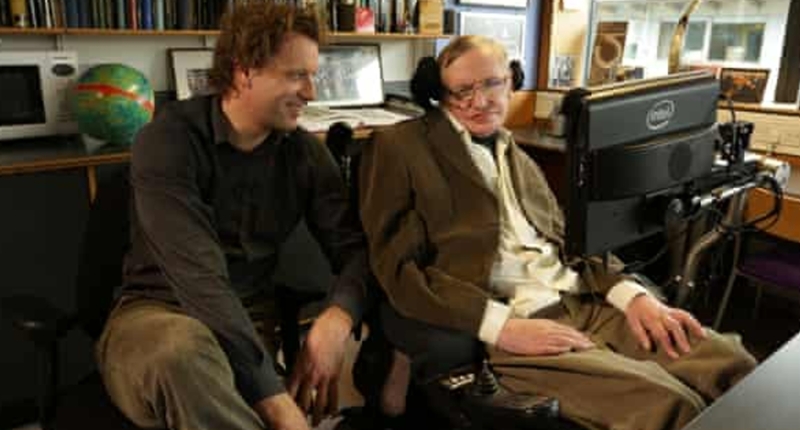Thomas Hertog, a collaborator of the late Stephen Hawking, revealed that Hawking believed his previous attempts to explain the emergence of life were inadequate, leading the two scientists to work together to develop a new theory of the cosmos. Despite Hawking’s deteriorating condition, their collaboration resulted in the creation of Hawking’s final theory, which forms the basis of their book, On the Origin of Time. The book takes a new perspective on the laws of physics and presents a new philosophy that rejects the idea of the universe as a machine governed by unconditional laws, instead viewing the universe as a self-organizing entity where emergent patterns appear, including the laws of physics. The book aims to challenge existing understandings of the universe and presents a new perspective on the relationship between physics and biology. On the Origin of Time will be published by Penguin Random House on 6 April.
Renowned cosmologist and author of the best-selling book, A Brief History of Time, Stephen Hawking, was said to have told his collaborator, Thomas Hertog, that his book was written from the wrong perspective. The revelation came during a meeting between the two in 2002, in which Hawking expressed his doubts about his own book. The publication, which sold more than 10 million copies worldwide, was eventually consigned to the waste bin by its own author, leading to a new collaboration between Hawking and Hertog.
Together, they worked on a new way to encapsulate their latest thinking about the universe, which is outlined in their new book, On the Origin of Time: Stephen Hawking’s final theory. Five years after Hawking’s death, the book will be published in the UK next month. Hertog will provide details about the book’s origins and themes during a lecture at the Cambridge festival on March 31.
The book seeks to explore the problem that Hawking encountered while trying to understand how the universe could have created conditions that are perfect for life to thrive. Some cosmologists believe that the delicate balance between particle forces that allow chemistry and complex molecules to exist, coupled with the fact that there are only three dimensions of space, are what allowed stable solar systems to evolve and provide homes for living creatures. The absence of these properties would have resulted in the universe not producing life as we know it.
The new book provides an opportunity for readers to gain insight into the latest thinking about the universe, particularly in relation to the creation of conditions that allow life to exist. The book highlights the importance of being open to change and new perspectives, even when dealing with one’s own work. Stephen Hawking’s admission that his own book was written from the wrong perspective underscores the importance of always being willing to learn and reevaluate one’s ideas.
Thomas Hertog, a collaborator of the late Stephen Hawking, has revealed that the cosmologist had thought his previous attempts at explaining the emergence of life were inadequate. This revelation led to the two scientists working together for the next 20 years to develop a new theory of the cosmos that could better account for the emergence of life. Hawking had come to the conclusion that he had been wrong and was looking to work on a new theory.
Hawking had been diagnosed with an early onset, slow-progressing form of motor neurone disease that gradually paralysed him, but despite his condition, he had been appointed as the Lucasian professor of mathematics at Cambridge University. Over the years, he had produced a series of remarkable theories about general relativity, black holes, and the origin of the universe, as well as his best-selling book, A Brief History of Time.
Hertog revealed that halfway through their collaboration, Hawking lost the remaining strength in his hand to press the clicker which he used to converse. He then switched to a sensor mounted on his glasses that could be activated by twitching a cheek muscle, but eventually, even that became too difficult. Communication slowed from a few words per minute to several minutes per word, and in the end, communication stopped. Hertog had to position himself in front of Hawking and fire questions, looking into his eyes to see if he was agreeing or disagreeing.
Despite the challenges they faced, their collaboration resulted in Hawking’s final theory, which forms the basis of On the Origin of Time, a book that takes its title from Charles Darwin’s On the Origin of Species. According to Hertog, the book deals with questions about our place in the universe and what makes our universe fit for life.
The book aims to make these questions central and tell their story from that perspective. In it, Hertog and Hawking discovered how physics can disappear back into the big bang, where their capacity to change has the final word in their theory. This sheds a new light on what cosmology is ultimately about, with physics and biology now on the same footing.
Their collaboration, which spanned two decades, is a testament to the power of determination and the willingness to explore new perspectives. Despite Hawking’s deteriorating condition, their joint efforts led to the creation of a new theory that challenges existing understandings of the universe.
The new perspective achieved by Hertog and Hawking, as outlined in their book, On the Origin of Time, reverses the hierarchy between laws and reality in physics and is “profoundly Darwinian” in spirit. The book presents a new philosophy of physics that rejects the idea that the universe is a machine governed by unconditional laws with a prior existence, and replaces it with a view of the universe as a self-organising entity where emergent patterns appear, including the laws of physics. On the Origin of Time will be published by Penguin Random House on 6 April. The book promises to challenge the way we understand the universe and presents a new perspective that questions existing understandings of the laws of physics.
Don’t miss interesting posts on Famousbio
